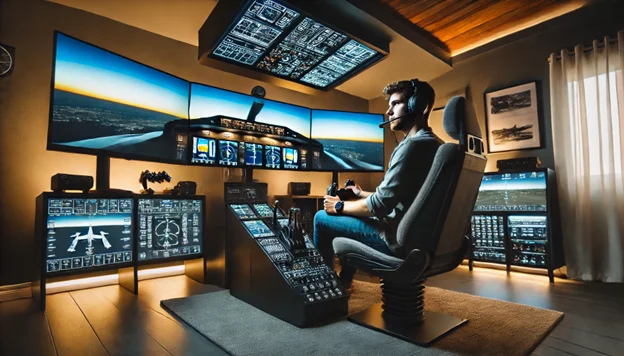Imagine soaring through the skies from the comfort of your home, controlling your aircraft like a professional pilot. A home flight simulator allows you to experience the thrill of flying without leaving the ground. Whether you’re an aspiring pilot or a flight enthusiast, building the perfect home flight sim setup can immerse you in a realistic and exciting aviation experience. In this guide, we’ll explore what you need to know to get started on creating the ultimate home flight simulator.
Choosing the Right Hardware
One of the most critical aspects of building your home flight simulator is selecting the proper hardware. The main components you’ll need are a computer, flight controls, and a display. A powerful computer with a high-performance graphics card is essential to run a flight sim smoothly, as you don’t want your experience interrupted by lag or crashes. In addition, flight controls like a joystick, throttle quadrant, and rudder pedals are vital for creating a realistic flying experience. For those who want an even more immersive setup, investing in a g1000 simulator can replicate the glass cockpit experience seen in modern aircraft, providing advanced avionics and flight instrumentation.
Picking the Best Flight Simulation Software
The software you choose will heavily impact your overall flying experience. Popular flight simulation programs like Microsoft Flight Simulator and X-Plane 12 offer highly detailed aircraft and realistic flight dynamics. When selecting your software, consider factors such as the types of aircraft available, global scenery, and the community’s support. If you’re interested in practicing real-world procedures, opt for a g1000 simulator to enhance your skills with advanced navigation and system management.
Creating a Realistic Environment
For the ultimate home flight simulator, your environment plays a big role in how immersive the experience feels. Multiple monitors or a VR headset can provide a panoramic view of the cockpit and surrounding skies. If you’re aiming for an extra layer of realism, consider building a cockpit enclosure that houses your flight controls and display, resembling an actual cockpit. This can transform your room into a genuine flying environment, making the flight sim feel incredibly lifelike.
Training and Education
A home flight simulator isn’t just about fun—it’s also an educational tool. You can use it to practice takeoffs, landings, and even emergency procedures in a safe environment. Many simulators offer tutorials and mission-based challenges to help you learn the basics of flying. If you’re a student pilot, a g1000 simulator can give you the edge in mastering avionics systems and preparing for real-world flight training.
Regular Upgrades and Maintenance
Once you’ve built your simulator, it doesn’t stop there. Flight simulation constantly evolves with new software updates, hardware improvements, and add-ons. Keeping your flight sim setup up-to-date ensures a cutting-edge experience. From updating your simulation software to adding new aircraft models or global scenery packs, regular upgrades can keep your simulator fresh and exciting for years to come.
Building your ultimate home flight simulator is a rewarding journey. It allows you to explore the skies in a way that’s tailored to your needs and interests. With the right hardware, software, and environment, you can create an incredibly realistic flying experience. Whether you want to practice real-world flying skills or enjoy aviation as a hobby, your personalized flight sim setup can take your passion for flight to new heights.

Shannon Reyes is a seasoned writer with a knack for crafting engaging blogs on a variety of service industries, including plumbing, cleansing, moving, pest control, and roofing. With a keen eye for detail and a passion for helping readers navigate complex topics, Shannon brings her expertise to life through informative and accessible content.











